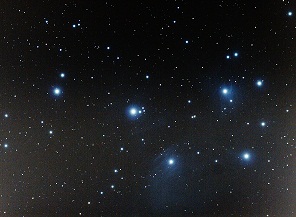|
M45 - Pleiades
In
astronomy, the Pleiades, or Seven Sisters (Messier object 45 or M45), is an
open star cluster containing middle-aged
hot
B-type stars located in the constellation
of
Taurus. It is among the nearest
star
clusters to Earth and is the cluster most obvious to the
naked eye
in the
night
sky. Pleiades has several
meanings in different cultures
and traditions.
The cluster is dominated by hot
blue and extremely luminous stars that
have formed within the last 100 million years. Dust that forms a faint
reflection nebulosity around the brightest
stars was thought at first to be left over from the formation of the cluster
(hence the alternate name Maia Nebula after the star
Maia),
but is now known to be an unrelated dust cloud in the
interstellar medium that the stars are
currently passing through. Astronomers estimate that the cluster will survive
for about another 250 million years, after which it will disperse due to
gravitational interactions with its galactic neighborhood.
The cluster core radius is about 8
light
years and
tidal radius is about 43 light years. The cluster
contains over 1,000 statistically confirmed members, although this figure
excludes unresolved binary stars.
It is dominated by young, hot
blue stars, up to 14 of which can be seen
with the naked eye depending on local observing conditions. The arrangement of
the brightest stars is somewhat similar to
Ursa Major
and
Ursa
Minor. The total mass contained in the cluster is estimated to be about 800
solar
masses.
The cluster contains many brown dwarfs, which are objects with less than about
8% of the
Sun's mass,
not heavy enough for nuclear fusion reactions to start in their cores
and become proper stars. They may constitute up to 25% of the total population
of the cluster, although they contribute less than 2% of the total mass.
Astronomers have made great efforts to find and analyse brown dwarfs in the
Pleiades and other young clusters, because they are still relatively bright and
observable, while brown dwarfs in older clusters have faded and are much more
difficult to study.

|
|
First try at M45
Taken on 12/29/2007
2 30-second exposures at ISO 800
13 60-second exposures at ISO 1600
Orion ED80
Hap Griffin modified Canon RebelXT 350D
No filters
Darks/Flats/Bias applied. |
|
|
|
|
|
|
|
|
|